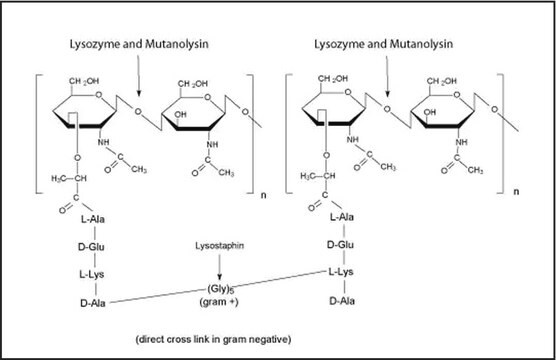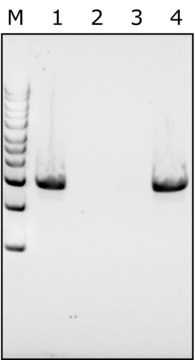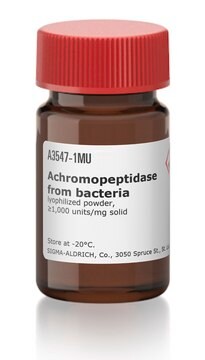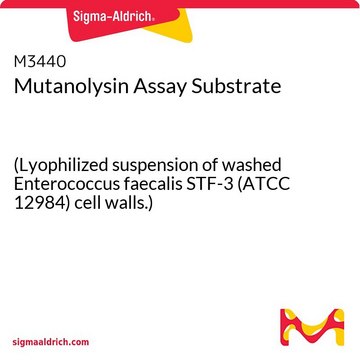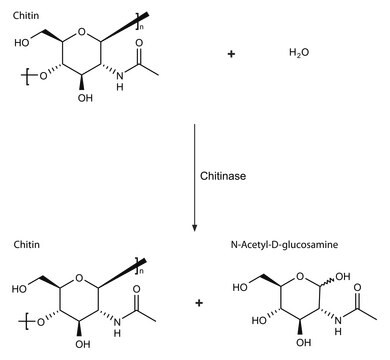MAC4L
MetaPolyzyme
lyophilized powder
Synonym(s):
Multilytic Enzyme Mix
Sign Into View Organizational & Contract Pricing
All Photos(2)
About This Item
UNSPSC Code:
12352204
NACRES:
NA.54
Recommended Products
form
lyophilized powder
Quality Level
technique(s)
DNA extraction: suitable
suitability
suitable for microbiology
application(s)
microbiology
shipped in
wet ice
storage temp.
−20°C
General description
Metagenomics analysis looks at all DNA that has been isolated directly from given single samples (e.g. environmental samples, biological organisms). Metagenomics allows for the investigation of microbes that exist in any environment (including extreme environments), and which have been historically difficult to isolate, culture, and study. Metagenomics has revealed the existence of novel microbial species. Applications of metagenomic studies include public health data analysis, discovery of novel proteins, enzymes and natural products, environmental studies, and agricultural investigations.
Application
MetaPolyzyme is a mixture of 6 enzymes that is intended for isolation of total DNA for metagenomics studies. Adapted from an initial formulation devised by S. Tighe,2 MetaPolyzyme was evaluated and developed in consultation and collaboration with the Association of Biomolecular Resource Facilities (ABRF) Metagenomics and Microbiome Research Group (MMRG). Test data on the use of MetaPolyzyme is accessible at the 2017 ABRF MGRG Poster.
Biochem/physiol Actions
Microbes can be difficult to disrupt because the cell walls may form capsules or resistant spores. DNA can be extracted by using lysing enzymes (such as lyticase or chitinase) to induce partial spheroplast formation. Spheroplasts are subsequently lysed to release DNA. MetaPolyzyme is intended for use in metagenomic studies, such as study of microbes and microbiomes of extreme and unique environments. MetaPolyzyme is intended for digestion of microbes for evaluation by whole genome shotgun sequencing for metagenomics and metatranscriptomic approaches.
Components
The enzymes in MetaPolyzme are:
- Achromopeptidase
- Chitinase
- Lyticase
- Lysostaphin
- Lysozyme
- Mutanolysin
Unit Definition
One unit will lyse 0.4 μg of Micrococcus lysodeikticus per minute by turbidimetric detection at 600 nm when suspended in buffer at pH 8.0 at 37 °C.
Signal Word
Danger
Hazard Statements
Precautionary Statements
Hazard Classifications
Resp. Sens. 1
Storage Class Code
11 - Combustible Solids
WGK
WGK 3
Flash Point(F)
Not applicable
Flash Point(C)
Not applicable
Choose from one of the most recent versions:
Already Own This Product?
Find documentation for the products that you have recently purchased in the Document Library.
Customers Also Viewed
Steve Hamner et al.
International journal of environmental research and public health, 16(7) (2019-04-03)
The Little Bighorn River is the primary source of water for water treatment plants serving the local Crow Agency population, and has special significance in the spiritual and ceremonial life of the Crow tribe. Unfortunately, the watershed suffers from impaired
Maria A Sierra et al.
Environmental microbiome, 17(1), 60-60 (2022-12-22)
Lake Hillier is a hypersaline lake known for its distinctive bright pink color. The cause of this phenomenon in other hypersaline sites has been attributed to halophiles, Dunaliella, and Salinibacter, however, a systematic analysis of the microbial communities, their functional
Nezar Noor Al-Hebshi et al.
Journal of oral microbiology, 11(1), 1557986-1557986 (2019-01-24)
Studies of the microbiome associated with dental caries have largely relied on 16S rRNA sequence analysis, which is associated with PCR biases, low taxonomic resolution, and inability to accurately study functions. Here, we employed whole metagenome shotgun sequencing, coupled with
Cartography of Opportunistic Pathogens and Antibiotic Resistance Genes in a Tertiary Hospital Environment.
Chng KR et al.
Nature Medicine, 26(6), 941-951 (2020)
Erratum to: The Metagenomics and Metadesign of the Subways and Urban Biomes (MetaSUB) International Consortium Inaugural Meeting Report.
Microbiome, 4(1), 45-45 (2016-08-20)
Articles
An overview of human microbiome research, workflow challenges, sequencing, library production, data analysis, and available microbiome reagents to support your research.
Our team of scientists has experience in all areas of research including Life Science, Material Science, Chemical Synthesis, Chromatography, Analytical and many others.
Contact Technical Service
